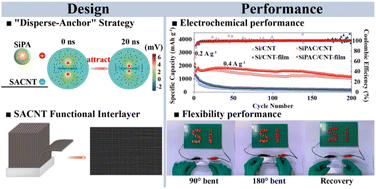Promising nano-silicon anodes prepared using the “disperse-anchor” strategy and functional carbon nanotube interlayers for flexible lithium-ion batteries†
Abstract
Nano-silicon (nano-Si) is considered a favorable candidate for next-generation lithium-ion batteries (LIBs) due to its high specific capacity, low discharge potential, and improved tolerance to volume changes. However, severe aggregation constitutes substantial impediments. In this work, first, a “disperse-anchor” strategy is proposed to improve the homogeneity of nano-Si electrodes. Positively charged polyaniline (PANI)-coated nano-Si (SiPA) and negatively charged super-aligned carbon nanotubes (SACNTs) construct the SiPA/CNT anode under the electrostatic interaction. Second, lightweight CNT interlayers are covered on the SiPA/CNT anode to alleviate the active material loss and promote cycling stability. Afterward, the SiPAC/CNT-film anode is obtained by transforming PANI into carbon through carbonization and exhibits an areal specific capacity of 2.77 mA h cm−2 at the 100th cycle. Moreover, the self-supporting CNT network contributes to excellent flexibility. After 10 000 cycles of 90° and 180° bending, the resistance of the SiPAC/CNT anode changes by only 2.66% and 3.14%, respectively. The pouch cell assembled with the LiFePO4 cathode and SiPAC/CNT-film anode maintains more than 96% capacity after 10 000 times of 90° bending. The “disperse-anchor” strategy and CNT interlayer effectively enhance the cycling stability and flexibility of nano-Si anodes, which are promising in the development of flexible commercial LIBs.



 Please wait while we load your content...
Please wait while we load your content...